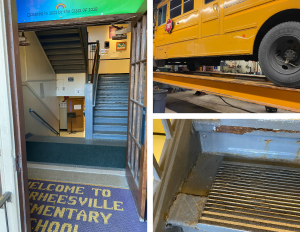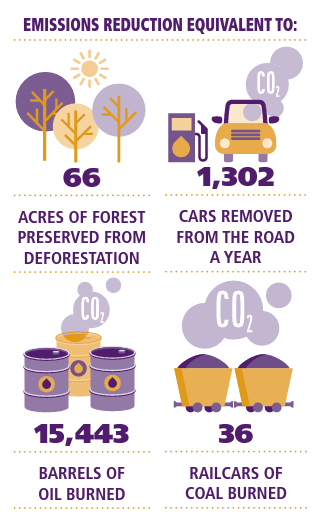Capital improvement project vote set for Dec. 6, 2022
Two separate propositions will be on the ballot for voters to consider
At its Oct. 3 regular meeting, the Voorheesville CSD Board of Education unanimously approved two capital project proposals totaling $27.2 million. The two propositions will be put forth before voters on Tuesday, Dec. 6, 2022.
The first proposition is the core project, at a cost of $25.2 million, which includes a majority of updates at the elementary school, a new transportation facility, and infrastructure updates.
Proposition 1 Scope Highlights
- Reworking existing space to create multiple general instructional spaces, including new music and arts classrooms, guidance suite, library makerspace and science labs
- Installation of a secure vestibule building entrance

Pictured: The current elementary entryway; a VCSD bus on an aging bus lift; dilapidated middle school stairs. - Centralizing the administrators’ and health offices
- Creating a new cafeteria in the existing transportation facility space, that will double as self-contained community space
- Elementary stairwell replacement to include ADA-accessibility
- Utilizing green space to create an outdoor instructional classroom
- Fixing the failing drainage system on the district’s soccer field
- Constructing a free-standing transportation facility at the rear of the
high school site with an entrance off Martin Road
- Installation of a secure vestibule building entrance
One of the biggest factors in the district’s decision to propose this project is growing enrollment. The district recently underwent two enrollment studies to examine its growing population and the effect that may have on school use.
The first study, a five-year district-wide school enrollment projection study, was conducted by the Capital District Regional Planning Commission (CDRPC). The district conducted a follow-up study that the Board of Education used to identify various elementary building configuration options that would accommodate the anticipated growth of the district. The findings of both reports include the potential for the addition of 350 new students into the district over the next 10+ years.
The reports looked at key indicators such as 20-year enrollment trends, birth rates, residential housing activity, and more, as a basis for developing these projections. The reports also took Guilderland’s Albany Country Club project into consideration.
Proposition 2 Scope Highlights
The second proposition on the ballot asks voters to approve an energy performance contract (EPC), for $2 million. This proposal does not impact the district tax levy, and is paid for through state funding and energy cost reductions.
An EPC is an initiative that allows school districts to take budgeted utility and operational costs and re-allocate them into energy saving capital improvements without the need for increased taxes.

Bundling this proposition into the upcoming December vote is a fiscally-responsible way to switch to energy saving protocols across campus–retrofitting LED fixtures in the middle and high school and installing new fixtures at the elementary school.
The project is expected to reduce the district’s greenhouse gasses and energy consumption to the equivalent of 1,302 cars removed from the road annually.
Other highlights of the contract include approximately $80k in annual energy savings, internal LED technology lighting fixtures and upgrades, updated temperature and ventilation control systems, weatherization, air sealing and insulation districtwide, and a new heating system for the high school pool complex.
If voters approve the project on Dec. 6, 2022, the district would be reimbursed for approximately 53% of the total project cost through state building aid. The capital project proposition authorizes the district to use $4.5 million in capital reserve funds to pay for this project. The remaining cost would be financed for a 30-year period.
Taxpayers would see an estimated maximum 2.5% increase in the tax levy through 2040. After that time, the tax impact would be reduced by 1.1% for the remaining 15 years of the borrowing. The estimated annual cost for a homeowner who has a home with a true value of $300,000 is $120 per year for the life of the loan, or $0.40 per $1,000 of true home value which decreases to $0.22 per $1,000 of true home value in years 16-30.
Frequently Asked Questions
Q: What is a capital project?
A: Just like a home, school facilities need regular attention and upkeep to continue to operate year after year as originally intended. The cost of keeping up with the daily wear and tear caused by thousands of students, staff, and visitors can rise above what the annual school budget can support. Capital improvement projects are a way for school districts to access state aid to complete a larger amount of facilities work than possible within the scope of the annual school budget. New York State Aid will cover approximately 53% of the district’s expenditures to offset the cost of these improvements.
Q: Why are we voting on this now?
A: The Board of Education seeks to continually make investments in our school buildings to provide a safe, competitive, and innovative environment for students to learn.
One of the major contributing factors in the district’s decision to propose this project is growing enrollment. The district recently underwent two enrollment studies to examine its growing population and the effect that may have on school use. The findings of both reports include the potential for the addition of 350 new students into the district over the next 10+ years. In order to meet the current and future needs of our school community, our buildings need to be able to accommodate more students, while also meeting their instructional needs. Revisioning the elementary school will allow the district to maximize space, while modernizing instructional classrooms, and better support student safety and security.
Q: How would this project benefit the community?
This project would benefit Voorheesville faculty, staff and community members, however, the group that would see the biggest impact is current and future students.
The two propositions would provide our students with more comfortable, safer, and secure learning environments through modernized learning spaces and infrastructure updates.
In addition, the energy performance contract (EPC) is expected to reduce the district’s greenhouse gasses and energy consumption to the equivalent of 1,302 cars removed from the road annually.
Q: How much would the project cost taxpayers?
If voters approve the project on Dec. 6, 2022, the district would be reimbursed for approximately 53% of the total project cost through state building aid. The capital project proposition authorizes the district to use $4.5 million in capital reserve funds to pay for this project. The remaining cost would be financed for a 30-year period. Taxpayers would see an estimated maximum 2.5% increase in the tax levy through 2040. After that time, the tax impact would be reduced by 1.1% for the remaining 15 years of the borrowing. The estimated annual cost for a homeowner who has a home with a true value of $300,000 is $120 per year for the life of the loan, or $0.40 per $1,000 of true home value, which decreases to $0.22 per $1,000 of true home value in years 16-30.

Q: What is an energy performance contract (EPC)?
An EPC is an initiative that allows school districts to take budgeted utility and operational costs and re-allocate them into energy saving capital improvements without the need for increased taxes.
Learn more: What is an Energy Performance Contract (EPC)?
Community Information Night held on Nov. 3
Thank you to the community members who attended the Nov. 3 information night. For those who were unable to attend, you may view the evening’s recording here.
